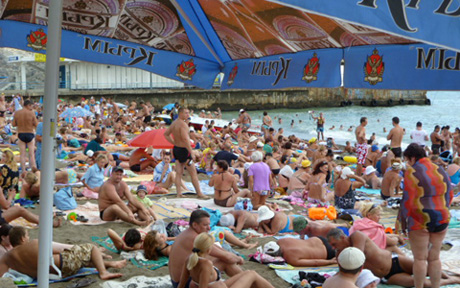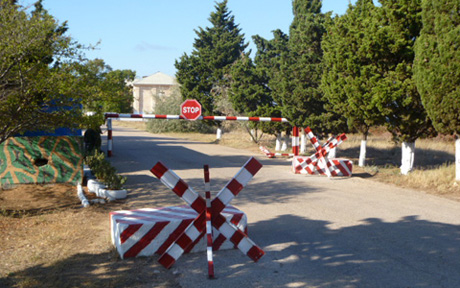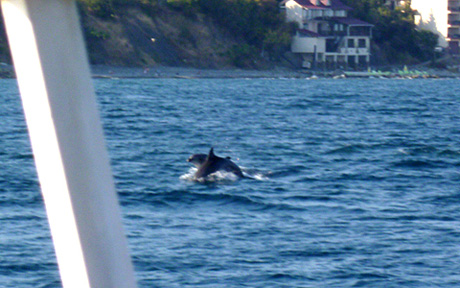Hunt for the red dolphin
They may look friendly, but they're stone cold killers
In the resort towns of the Crimea, holidaymakers from the heartlands of Russia laze on short beaches of lumpy shingle, the Black Sea lapping at their feet. They lie on straw mats, fat red bellies up like beached manatees, hardly a gap visible between them. Occasionally one turns over, like a pancake flipping itself on the hob.

My comrade and I have escaped death by beach and are in the streets of Sevastopol, still home to a large portion of the Russian fleet. We are on a mission – to see a dolphin. Ever since I heard the Black Sea was teeming with them, I was fixated.
The main Sevastopol dolphinarium is closed the day we visit. But a dolphin hunter is made of sterner stuff. Not two minutes down the street we pick up another lead. A short bus ride away, a helpful Babushka crones, there is another dolphinarium which isn’t in the guidebooks. What’s more, she says, its dolphins are more genuine than the ones here – who I can only assume are paint-jobbed porpoises.
That's how, forty minutes later, we find ourselves ten miles out of town, chasing after secret dolphins on the nodding assurances of a gold-toothed granny. The bus has steadily been filling up with young soldiers as civilian passengers disembark, as if by military osmosis. We check with the driver if we are on the right route. Dolphins? He puzzles for a terrible moment. Ah yes, dolphins! Last stop.
Last stop and we get off – at a military base in line of fire of a to-scale model tank. Five minutes up the road we hit a blockade. A bar saying “Stop” obstructs our way, guarded by two Russian buzz cuts with rifles. Again conscious that we may momentarily be about to look like idiots, we ask them if there are dolphins inside. They let us through without a word, as if we had given the correct password.

We walk up a winding concrete road, past a Russian flag and more soldiers. At a fork ahead, our faith is finally rewarded by two signposts: “Dolphinarium A” and “Dolphinarium C”. Dolphinarium B is clearly so secret they don’t want you to even guess at its existence.
At last we reach a military bunker. High walls topped with barbed wire guard a formidable gate, to one side of which is a turnstiled entrance with a reception desk manned by a Babushka built like a siege engine. I don’t speak Russian, so my comrade does the talking:
– Good afternoon. Is it possible to see the dolphins?
– No.
– Are there in fact dolphins at all?
– Yes.
– Why can’t we see them?
– Comrade, this is a military facility and these are battle-trained dolphins. You cannot see them unless you have an appointment.
There is no arguing with her. It turns out you can not only see but swim with the battle trained dolphins, if you book well in advance and pay an exorbitant fee. But we have neither booking nor bribe, and have no choice but to turn tail like the pair of non battle-trained land mammals we are, and walk back to the bus stop.
Later, I go online to find out more. “The Soviet Navy”, I read, “operated a research facility to explore military uses of marine mammals at Kazachya Bukhta, near Sevastopol, 44.5800°N 33.4023°E.” I put the coordinates into Google maps, and sure enough – that’s our bunker. We had stumbled into a decommissioned Soviet military base, home to the last of the Communist dolphins.
Further digging reveals the chief military use of dolphins as locating underwater mines, submarines and “other enemy combatants”. And it’s not just the Reds who got up to such tricks. The US Navy has been training dolphins and sea lions out of San Diego since 1962, and most recently had them clearing mines in the Persian Gulf during the Iraq war.
Less substantiated – but much more fun – rumours include killer dolphins fitted with bayonets and poison darts on their beaks, and kamikaze dolphins strapped with explosives, trained to blow up ships and submarines. My favourite is the suggestion that the USA and USSR were secretly engaged in out and out dolphin-vs-dolphin warfare all along, unknown to the rest of us, underneath the waves.
I feel sullied by this new knowledge. I close my eyes and try to picture the frolicking dolphin whose life of undersea ease I had so envied. Instead, a battle-scarred monster materialises in my mind’s eye, a combat knife in each flipper and a grenade clutched in its beak. What hope is there left for playtime if man has weaponised its friendliest mascot?
The day before we leave the Crimea, boating along the coastline past Chekhov’s dacha, I see two wild dolphins. They pop out of the water unexpectedly, like bread coming out of a toaster too early, and slalom between water and air for a few turns before disappearing below. I stare at the heaving sea after them for an age, but they are gone. It's all I had wanted, and my faith is restored.
Until, with the faintest unease, I wonder … are they following me?


















